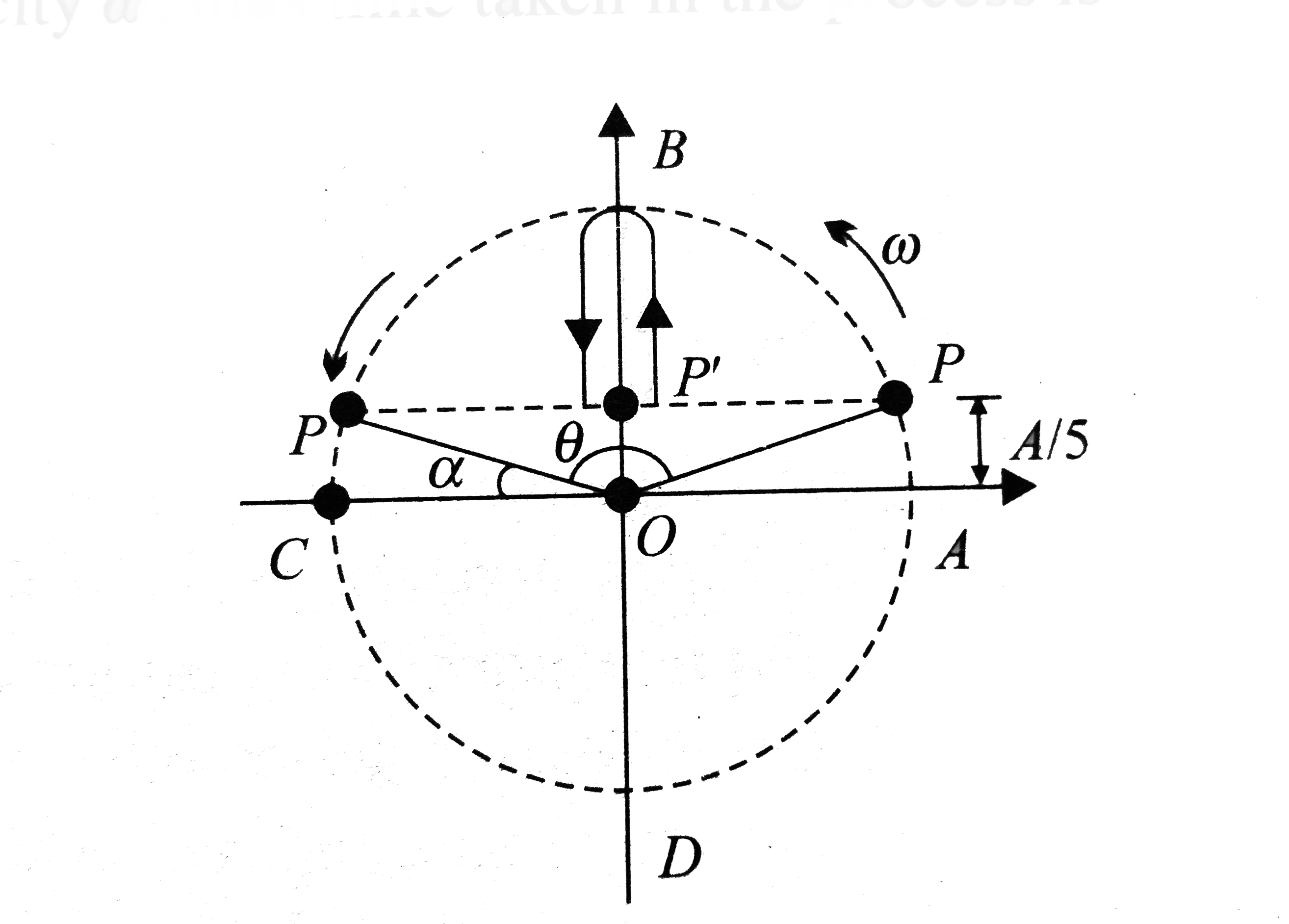A partical excutes SHM with amplitudeA and angular frequency ω. At an instant the particle is at a distance A/5 from the mean position and is moving away from it. Find the time after which it will come back to this position again and also find the time after which it will pass through the mean position.
figure show the circular motion repesentatuion fot the partical P give in problem. The initial situation of partical is shown in the figure. As P moves , its initial position when P will go up and then come back to its initial position when P reaches to the corresponding position in the second quandrant as shown. In this process P traversed an angular displacement θ with angular velocity ω , thus time taken in the process is 
t=θω=1ω[2cos−1(1/5)]=2cos−1(1/5)ω
Now when P reaches point C,P will each its mean position . Thus, time taken by P from its initial position to point C is
t=(π−α)ω=π−sin−1(1/5)ω
The same time P will take from A/5 position t mean position through its exterme position.
Topper's Solved these Questions
- BOOK - CENGAGE PHYSICS ENGLISHCHAPTER - LINEAR AND ANGULAR SIMPLE HARMONIC MOTIONEXERCISE - Solved Example15videos
LINEAR AND ANGULAR SIMPLE HARMONIC MOTION
- BOOK - CENGAGE PHYSICS ENGLISHCHAPTER - LINEAR AND ANGULAR SIMPLE HARMONIC MOTIONEXERCISE - Exercise 4.123videos
LINEAR AND ANGULAR SIMPLE HARMONIC MOTION
- BOOK - CENGAGE PHYSICS ENGLISHCHAPTER - KINETIC THEORY OF GASES AND FIRST LAW OF THERMODYNAMICSEXERCISE - Interger11videos
KINETIC THEORY OF GASES AND FIRST LAW OF THERMODYNAMICS
- BOOK - CENGAGE PHYSICS ENGLISHCHAPTER - MISCELLANEOUS KINEMATICSEXERCISE - Interger type3videos
MISCELLANEOUS KINEMATICS
Similar Questions
particle is executing SHM of amplitude A and angular frequency omega.The average acceleration of particle for half the time period is : (Starting from mean position)
View SolutionAt particle is executing SHM with amplitude A and has maximum velocity v0. Find its speed when it is located at distance of A2 from mean position.
View SolutionA particle executes SHM with a time period of 4s. Find the time taken by the particle to go directly from its mean position to half of its amplitude.
View SolutionThe equation of a S.H.M. of amplitude A and angular frequency ω in which all distances are measured from one extreme position and time is taken to be zero at the other extreme position is
View SolutionA particle executes shm with an amplitude of 10 cm and a period of 5 s. Find the velocity and acceleration of the particle of a distance 5 cm from the equilibrium position.
View SolutionA partical excutes SHM with an angular frequency ω=4πrad/s. If it is at its extereme position initially, then find the transition when it is at a distance √2/2 times its amplitude from the mean position.
View SolutionAcceleration of a particle in SHM at displacement x=10cm (from the mean position is a=−2.5cm/s2). Find time period of oscillations.
View SolutionA mass m is undergoing SHM in the verticl direction about the mean position y0 with amplitude A and anglular frequency ω. At a distance y form the mean position, the mass detached from the spring. Assume that th spring contracts and does not obstruct the motion of m. Find the distance y. (measured from the mean position). such that height h attained by the block is maximum (Aω2>g).
_E01_175_Q01.png) View Solution
View SolutionA particle performs SHM with a period T and amplitude a. The mean velocity of the particle over the time interval during which it travels a distance a2 from the extreme position is xa2T. Find the value of x.
View SolutionA particle performs SHM with a period T and amplitude a. The mean velocity of particle over the time interval during which it travels a/2 from the extreme position is
View Solution

